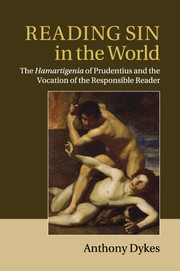Book contents
- Frontmatter
- Contents
- Acknowledgements
- Abbreviations, manuals and works of reference
- Bible texts used
- Classical texts used
- Electronic resources
- The names of biblical characters
- Vocabulary and style
- 1 Introduction: ‘Prudentius counts’
- 2 The world projects human responsibility
- 3 The vocation of the responsible reader: the biblical strategy
- 4 The vocation of the responsible reader: the genre strategy
- 5 Conclusion
- Appendix A A note on the title of the Hamartigenia
- Appendix B A brief note on the date and circulation of the Vulgate Genesis
- Bibliography
- Index
2 - The world projects human responsibility
Published online by Cambridge University Press: 03 May 2011
- Frontmatter
- Contents
- Acknowledgements
- Abbreviations, manuals and works of reference
- Bible texts used
- Classical texts used
- Electronic resources
- The names of biblical characters
- Vocabulary and style
- 1 Introduction: ‘Prudentius counts’
- 2 The world projects human responsibility
- 3 The vocation of the responsible reader: the biblical strategy
- 4 The vocation of the responsible reader: the genre strategy
- 5 Conclusion
- Appendix A A note on the title of the Hamartigenia
- Appendix B A brief note on the date and circulation of the Vulgate Genesis
- Bibliography
- Index
Summary
This chapter falls into three main areas of discussion. The first concern is to trace the argument of the poem itself, that the human will is not only powerful enough to reject God's will (and the devil's snares) but is powerful enough to change the very configuration of the world. Therefore landscape reveals human depravity. Sin is the cause of the distortions in creation. This misuse of the human will is revealed, through landscape, at two levels: the level of original sin and the level of actual sin. We see the two distinct types of misuse of the will revealed in two landscapes. These two different landscapes, which the human will creates, are revealed to the reader in the exemplum of two ‘Fratres’, readers of the world, who are confronted with a decision about two types of landscape at a junction in the road (789–801). The second section of the chapter examines a highly ‘painted’ sequence in the poem. It is a key passage, and it would be useful to describe it as a ‘panel’, as it is a distinct portion of the Hamartigenia, and in that way not unlike a leaf of a triptych; but it is a sequence which is intimately related to the global task of discerning the poem's meaning. A full examination of the panel of the ‘Fratres’ reveals to the responsible reader the erotic content of actual sin, as actual sin is understood and presented by Prudentius.
- Type
- Chapter
- Information
- Reading Sin in the WorldThe Hamartigenia of Prudentius and the Vocation of the Responsible Reader, pp. 39 - 101Publisher: Cambridge University PressPrint publication year: 2011

